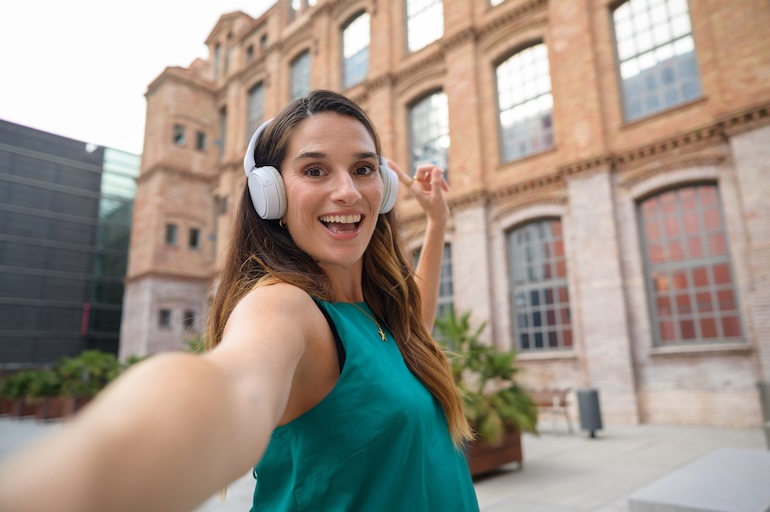 August 15, 2025
August 15, 2025
A heritage audio guide turns objects, rooms, and landscapes into living stories. It gives every visitor a clear, personal route—in their own language—without adding pressure to your team or budget.
What a heritage audio guide does
- Right story, right place. Visitors scan a QR code or enter a number to play a short track.
- Bring-Your-Own-Device. Guests use their own phones—no queues, charging, or cleaning handsets.
- Multilingual by default. One guide can serve international visitors and local communities.
- Offline friendly. Works in basements, thick-walled buildings, churchyards, castles, and rural trails.
- Head-up experience. Eyes on the place, not the screen.

Visitor benefits
Deeper, more memorable stories
Audio frees people to look, listen, and imagine. A calm narrator, period sounds, or community voices can turn a “thing” into a “moment”.
Language and pace for everyone
Visitors choose their language and move at their own speed. Families can pause; enthusiasts can explore optional deep dives; casual visitors can keep it short.
Respect for the site
Short wayfinding tips reduce bunching, keep people on paths, and protect fragile interiors and surfaces.
Accessibility and inclusion
- D/deaf & hard-of-hearing: transcripts and captions.
- Blind & partially sighted: audio description and clear orientation cues.
- Neurodiverse visitors: predictable structure, calm tone, optional “quiet” versions.
- Easy Read options: short, plain-language tracks for all ages.
Operational benefits for your team
Fewer repetitive questions
Include “house rules” and wayfinding in the first track, saving stewards from repeating guidance all day.
Smoother visitor flow
Use short intros and suggested routes to ease pressure on tight rooms, stairs, and delicate areas.
Lower print and signage costs
Shift from heavy text panels to lighter prompts. Update audio anytime without reprinting.
Re-usable content
The same heritage audio guide tracks can live on your website, in schools packs, and on social channels.
Simple insights
Privacy-friendly stats show which stops people play and which languages matter—useful for planning staffing and future stories.
Revenue and fundraising
Give at the right moments
A gentle prompt at the end of a moving story—“If this piece spoke to you, consider a £3 gift to preserve it”—outperforms generic signage.
Ethical upsells
Offer an extended trail, curator commentary, or family quests as small add-ons that feel like value, not pressure.
Build memberships and return visits
Close with invitations to seasonal trails, evening tours, or workshops—turn a one-time visit into a relationship.
Perfect for outdoor heritage & trails
A heritage audio guide shines on battlefields, industrial sites, churchyards, gardens, coastal paths, and town heritage trails. With offline playback, visitors keep listening when signal drops. Numbered posts or QR markers are robust and easy to maintain.
Costs and care: pragmatic, not painful
- BYOD saves money. No buying, charging, or sanitising handsets.
- Start small. Launch with 8–15 stops; add more once you see what resonates.
- Record with what you have. A quiet room and a good phone mic can sound excellent.
- Lean on local voices. Volunteers, curators, and community elders add authenticity.
- Maintain lightly. Update a track when an object moves or a route changes—no reprint bills.
A simple recipe for one great audio stop
Aim for 60–90 seconds: hook, one big idea, an invite to look or listen, and a tidy landing.
Template
- Title: The North Door: Pilgrims’ Entrance
- Hook (1 sentence): Every winter, lanterns dotted this path as travellers arrived cold, muddy, and hopeful.
- One idea (3–4 sentences): Share the human story, a surprising detail, or a tension that makes people care.
- Invite to look (1–2 sentences): Run your eyes along the stone; notice the shallow footprints carved by centuries.
- Close (1 sentence): When you’re ready, continue to Stop 7 by the yew tree.
- Optional donate line (soft): If stories like this matter to you, a small gift helps keep them alive.
Writing tips
- Use spoken language, not panel language.
- One idea per track; cut ruthlessly.
- Prefer active voice and present tense: “You’re standing where…”
- Add light sound texture sparingly (a bell, a door creak).
- Name people. Dates and facts matter, but names make memory stick.
- Test with five visitors: one local, one tourist, one child, one older adult, one access-focused visitor.
Getting started checklist
- Pick one route (8–15 stops) that tells a complete story.
- Map step-free alternatives and note them in the guide.
- Draft scripts; read aloud; trim to time.
- Record and lightly edit; add transcripts.
- Place numbered markers or QR codes; ensure offline playback works.
- Soft-launch for a week; collect comments; update fast.
- Add a kind donation prompt and a “what to see next” track.
Why now?
Visitor expectations have changed: people want flexible, personal experiences that work on their phones and in their language. A heritage audio guide delivers that without adding pressure to your team or the fabric of the place.



